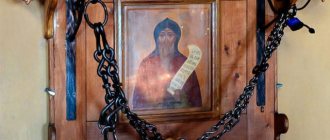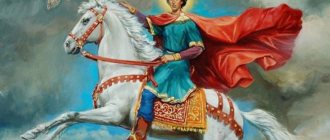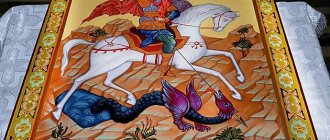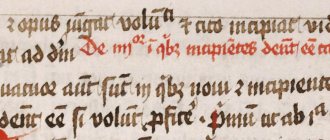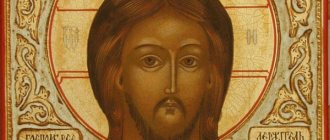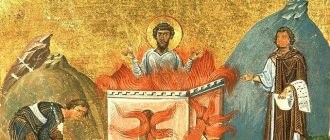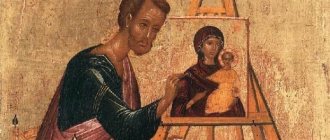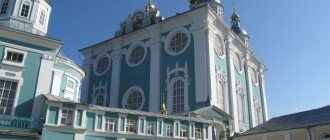| St. Abraham and martyr. Mercury Smolensk. Russian icon (1722). Minsk, State Art Museum of Besorussia |
Mercury of Smolensk
(+ 1239), warrior, martyr
Not to be confused with the Venerable Mercury of Pechersk, Bishop of Smolensk, who died at the hands of Batu in the same year.
Commemoration on November 24 and in the Cathedral of Smolensk Saints
Warrior, descendant of a princely family. Raised in Orthodoxy, the holy warrior secretly led an ascetic life: he was a strict faster, a virgin, every night he secretly sang thanksgiving praises to the Lord from everyone. At this time, in 1239, the Tatar hordes of Batu approached Smolensk and stood 25 versts from it, on Dolgomostye, threatening the city and its shrines with ruin. Hearing about the approach of evil enemies, about the destruction of God's temples, St. Mercury grieved and was sick in soul; Every day he became more and more inflamed with divine jealousy, wanting to suffer and lay down his soul for the faith of Christ. And his prayer was heard.
In the cathedral church, a certain sexton prayed in front of the icon of the Most Holy Theotokos, asking with tears to deliver the city from its enemies. Suddenly he heard a voice from the icon: “Go to my servant Mercury in Podolia and quietly tell him: the Lady is calling you.” When the warrior came to the cathedral, he himself heard the voice of the Most Pure Virgin, sending him to battle the enemy and promising heavenly help, a crown of victory and eternal bliss.
St. Mercury was filled with great joy, for the Queen of Heaven herself promised him what he had long been striving for with all his soul: to suffer for his brothers and for the faith of Christ. That same night, the warrior of Christ went to the Tatar camp in Dolgomost and entered into single combat with the enemy horde. Calling on the name of the Lord and the Most Pure Mother of God, the holy warrior destroyed many enemies. The Tatar warriors saw with horror that St. Mercury is helped in battle by lightning-fast men and a radiant Woman, and unable to resist the warrior of Christ, they fled. St. himself Mercury died in battle.
The inhabitants of Smolensk, saved by the miraculous intercession of the Lord and the Most Holy Theotokos, honorably buried the body of the holy warrior-martyr in the cathedral in honor of the Dormition of the Most Holy Theotokos. Its celebration was established at the end of the 16th century. Already in 1509, the residents of Smolensk called him their main protector.
Life of the Holy Martyr Mercury
The name of the holy warrior Mercury is associated with the historical fact of the deliverance of the Russian city of Smolensk from the siege and assault by Batu’s troops. We gleaned information about how our Lord Jesus Christ became glorified through the warrior Mercury from a written monument dating from the second half of the 15th - early 16th centuries. and called “The Tale of Mercury of Smolensk.” The monument was preserved in the only list of the 17th century. Despite the wide range of dates between the events described by the monument and the appearance of the list (XIII-XVII centuries), researchers say with confidence that the surviving document fully conveys the plot of the protographer, and he, in turn, undoubtedly reflected the oral legend composed during the Tatar yoke about the holy warrior-hero Mercury. There are also quite a few lists of more “bookish” items, i.e. a literary version of the legend of Mercury, on which, we note, the service to the saint is also based. We will mostly refer to the above source as being more similar to the original tradition; but the “processed” or “book” version will help us provide some additions and explanations.
The plot of the Smolensk legend is to a certain extent typical of the Slavic and Russian epic, which originated in pre-Christian times, received an additional impetus for development in Christian Rus' during the period of princely civil strife, flourished profusely during the Tatar-Mongol yoke and was finally formed by the 16th-17th centuries. In this epic, one of the characteristic plots is the story of the siege of a Russian city by an enemy (external or from internecine warfare), the suffering of the besieged, the defense of the city by a warrior-hero, a bearer of the ideal of not only physical strength and military valor, but also morality and devotion to his native land and fellow tribesmen, as well as - with the adoption of Christianity - faith and piety. The hero stands alone against the enemy and wins a military victory; however, during the bloody battle he receives mortal wounds, after which, returning to his native city, he dies from his wounds; nevertheless, his sacrificial death is the source of life for the city. The last circumstance is often emphasized especially by the direct speech of the protagonist: at the decisive moment, he and his squad express a desire to “lay down their heads,” which almost literally repeats the Gospel “definition” of true love as a principle that makes it possible and necessary to “lay down one’s soul for one’s friends.” Vivid examples of such a feat are the images of the Kyiv hero Sukhman Adikhmantyevich (Domantyevich), Pereyaslavsky - Demyan Kudenevich, as well as the Ryazan hero - Evpatiy Kolovrat.
Batu’s troops, as established, did not approach Smolensk (the question of the historical authenticity of the local battle between reconnaissance detachments of both sides outside the city remains debatable); passing from north to south, from the Novgorod lands to the steppe zone, they, having the opportunity to cross to the southern bank of the Dnieper, on which the city of Smolensk stood, and besiege and storm the Smolensk Kremlin, did not take the city, crossing the Dnieper thirty kilometers to the south -east; those. literally “passed by.” The deliverance of Smolensk was interpreted as the Grace of God, revealed in the feat of the holy hero Mercury.
Model of the Smolensk Kremlin on the eve of the Polish siege of 1609-1611. In the center is Monomakhov Assumption Cathedral
So, the Legend says the following.
In Smolensk, on Podol, at the Petrovsky end (in the original - “Petrovskaya hundred”), beyond the Dnieper (i.e. on the northern bank of the Dnieper), lived a young man named Mercury. He was so godly that one could say that he shone with faith in the midst of the world. The “Revised Version” adds the following detail: Mercury was from “Roman countries, but of the Greek faith” and was in the service of the Smolensk prince. A variant of this version states that Mercury was from Moravia.
Mercury, continues the “Tale,” constantly prayed before the Cross of Christ for peace. The “Book Version” explains: The cross stood in front of the township church in honor of the holy apostles Peter and Paul, in the Petrovskaya side. This cathedral is a fine example of pre-Mongol architecture; in our time, it was reconstructed (1963, P.D. Baranovsky) in accordance with the trends of pre-Mongol Kiev-Chernigov architecture, genetically dating back to Byzantium.
Cathedral of Peter and Paul at the Petrovsky end. Smolensk, XII century.
At this time, Batu’s hordes were approaching Smolensk. The troops of Batu (Batu) and Subedei, after the devastation of North-Eastern Rus', moved towards Novgorod, but, having reached the impenetrable swamps and dense forests of the Novgorod land, they could not advance further and turned south into the steppe (it is known, however, that they made a victorious campaign in Eastern Europe, in particular, was conquered by Hungary. According to the Legend we are considering, this campaign took place after Smolensk); Thus, Novgorod escaped the Mongol conquest, and the path of the Mongol tumens (ten-thousand-strong “divisions”) to the steppe now had to pass through the Dnieper in the region of Smolensk, which stood on the southern bank of the great river on a high hill.
Somehow, the rumor of an army approaching from the north reached the Smolensk people and plunged them into horror. Where does Batu intend to cross the river? The citizens of Smolensk, continues the “Legend,” left the settlement and persistently stayed in the “city” (i.e., in the Kremlin, on the southern bank of the Dnieper), in the cathedral church of the Most Pure Mother of God, that is, in the Assumption Cathedral, built by Vladimir Monomakh at the beginning of the 12th century . (the temple did not survive - it was severely damaged by the explosion of gunpowder warehouses during the siege of 1609-1611 by the troops of the Polish-Lithuanian Commonwealth and was dismantled at the end of the 17th century. Later, the current Assumption Cathedral was built in its place in the Kiev Baroque style), praying in front of the image of the Virgin Mary Guide (Hodegetria Brought by Monomakh from Chernigov to Smolensk, from then on it received the name “Smolensk”. Lost during the Great Patriotic War). And the Providence of Almighty God for that city manifested itself in this way: beyond the “Nepr River”, at the northern end there was the Pechersk Monastery, the Mother of God appeared to the sexton of the cathedral church, commanding him to find Her saint Mercury and convey the following words: “The Mother of God is calling you.”
Icon of the Mother of God Hodegetria of Smolensk
The sexton rushed to carry out the command. Having found Mercury praying at the Cross, he brought him to the Pechersk Monastery, where the warrior was honored to see the Most Holy Virgin on a luminous throne, “having in the bosom” the Infant Emmanuel and “being surrounded by heavenly warriors” (obviously, this is an image of the type “He rejoices in You...”, which became widespread in the 15th-16th centuries, during the written recording of the legend of Mercury; it is possible, however, that the earlier “Sign”, for versions with flanking six-winged “seraphim” are known). The Mother of God called on Mercury to drive away those who resisted from Smolensk. After he accomplishes this, the Angel of the Lord will appear to him, to whom Mercury must “surrender” his weapon (option: “all armor”), and with him his very head. This will be the end of his feat and the beginning of Heavenly glory. Mercury, in fear and trembling, bowing to the ground to the majestic Image that appeared, leaves the church and immediately finds the mighty horse given to him by Heaven - and, “all the way,” rushes towards Batu and defeats his army, “galloping bravely through the regiment, flying like an eagle through the air,” immediately freeing “captive Christians and releasing them into their city.” Batu, in horror and “in the smallest squad”, runs in panic away from Smolensk. The “processed” version of the Legend defines the place of the battle as Dolgiy Most, or Dolgomostye, 25-30 km southeast of Smolensk. And soon the enemy was “killed quickly on the Ugra by Tsar Stefan.” And here the Legend, obviously, puts together, following the spirit of the epic, the name of the Hungarian king-enlightener Stephen, who lived in the 10th century, and the famous - and already existing at the time of written recording - “standing on the Ugra River” (1480), which marked the end of the Mongol-Tatar yoke in Rus'. Let us recall that Batu’s hordes actually existed in Hungary, but Batu was not killed there; quite the contrary, the “Ugric country” was captured by him.
Smolensk. Fortress wall. Photo by S.M. Prokudin-Gorsky, 1912
And so, having dispersed the hordes of Batu, Mercury turns around and sees a terrible and magnificent warrior, in whose image he recognizes the Angel of the Lord and gives him “all his weapons,” bows to the ground in front of him and waits for the fulfillment of what the Mother of God said. It is difficult to say how to correctly understand “all weapons”: the entire set of weapons, just one shield, or, finally, the wonderful invincible force itself. We adhere to the latter understanding, without excluding the first two. The fact is that two words: “everything” and “weapon”, may in an earlier version turn out to be one word “all armor”, in the Cyril-Methodian tradition of translating liturgical texts from Greek, conveying the biblical and hymnographic meaning of the Greek οπλων, “universal, impregnable, miraculous protection surrounding on all sides, at the same time being a deadly weapon against the enemy.” Mercury does not have to wait - the Angel cuts off his head: the mission is completed. In the “book” version, the episode with the Angel is replaced by a more understandable “human factor”: Mercury is suddenly deprived of his head, after the completion of a fleeting night battle in a sleeping enemy camp, by the son of a Mongolian hero defeated by Mercury, previously indicated by the Mother of God, who attacked the Smolensk warrior in a fit of revenge for his father.
Mercury - as the Mother of God had commanded him - takes the severed head in his hand and, mounting his war horse, returns to Smolensk. People who met a headless horseman on the road, as the Legend tells, were amazed at the “Building of God.” At the same time, not everyone had such a spectacle that evoked exclusively positive emotions: both the “early” and “book” versions of the Legend for some reason mention a maiden leaving the city on the water, who, seeing a horseman entering the Kremlin at the “Mologinsky” gate, with his head, out of place, so to speak, she began to “abuse him absurdly.” The episode with the brave girl, who, despite her youth, was obviously well acquainted with the wealth of folklore archaic layers of the Old Russian language, seems to us to be no coincidence: she thought that she had encountered the “undead” and tried to “curse” him with “multi-story” mantras known to her from her grandmothers. But what she encountered “at the gate” was incomparably deeper.
Irish mythology knows such a character as the Dullahan - a malevolent spirit (which served as material for the famous novel by Myne Reid "The Headless Horseman"), taking the form of a horseman holding his own (of course, severed) head under his arm or tied to the saddle; and this head, as a rule, speaks (note that according to the “book” version of the legend about Mercury, the latter’s head tells the assembled Smolensk residents about the circumstances of the battle at the Long Bridge). However, the image of the dead horseman is wider and deeper than the Irish “special case”; the evil spirit is a relatively late idea, profaned by an unaccountable fear of death, of the already incomprehensible and forgotten image of a “mediator” between the living and the dead; this “mediator” is also a sacrifice made, ultimately, so that the dead become alive again. The honorable installation of a warrior killed in battle on his war horse is an ancient funeral ritual, like the domestication of the wild horse itself, which is at the same time a sacrifice, the fulfillment of the voluntary sacrifice that this warrior made in the form of his life - laying down his soul “for his friends”, for native tribe, for the land, for neighbors. The Sun Horse must complete its journey, make the last “stop” in Heaven, at the metaphysical “Hitching Post”, which is the “World Tree” and the spiritual Axis of everything, that invisible Thread on which all things, all worlds are strung, like beads, and without which they are nothing. So, the dead warrior on a wonderful solar horse returns to the Core and Breath of everything, to the Tree of Life. Mercury prayed at the Cross of Christ - to the Cross of Christ, to the Tree of Life and returned his wonderful horse-sun. By the way, the gate with the name “Mologinsky” is unknown from anywhere except our “Legend”; historians reconstruct as supposed some “Molokhovo” gates leading to the Molokhovo volost and further to Mstislavl. But it is worthy of attention that far to the north of Smolensk, in the Rostov lands (now the Yaroslavl region), the Mologa River flows, famous for the fact that at its confluence with the Volga, during the spring flood of 1149, the internecine war between the Kyiv prince Izyaslav Mstislavich ended peacefully and Rostov and Suzdal Yuri Dolgoruky. It is reasonable to assume the presence in ancient Smolensk of a northern gate, popularly called by the name of the Russian river known at that time. The name of the river is ancient, goes back to Sanskrit and is composed of several roots: “mr”, or “m”, denoting death, also measure, fate, and “ol”, “road”, “path”; Thus, Mologa is “The River is the Path of souls to Eternity, in each person’s measure.” And this Path is northern, oriented towards the North Star, i.e. to the Pole. Here we see again the symbolism of the Celestial Axis. So, the dead psychopomp rider on the solar horse comes along the Path of Eternity and brings Peace. He does not have his own head - his Head is now Invisible, for “it is not he who lives, but Christ lives in him,” the Tree of Life, the One Head of everything, the One Pole, the Principle and Life of everything.
Mercury, the “Tale” further reports, dismounted from his horse and (according to the “book version” - after telling the townspeople about delivering them from danger) gave up his spirit to the Lord; the horse became invisible: the weapons of victory, along with the warrior’s life, were “taken” back to Heaven. Realizing that there is a Miracle before them, the Smolensk people call the archbishop; further, the “Tale” reports that the saint lay at the gate for three days, the church procession could not approach him. Only on the third night, the archbishop, praying without sleep, heard a Voice that said: “He who sent to victory will bury him,” and saw the Mother of God, accompanied by the archangels Michael and Gabriel, who lifted the relics of the saint and transferred them to the Assumption Cathedral. After this, the relics of Saint Mercury remained in the Assumption Cathedral, exuding healing. At the beginning of the 17th century. Monomakh Cathedral was blown up and was never restored to its previous form; the relics of the holy warrior are then lost.
Unusual Science
— Eduard Anatolyevich, you are engaged in hagiography. What does this science study?
Hagiography studies the lives of saints and all written monuments that are associated with them. Science is not very ancient, but in the modern world, of all the theological disciplines that are in one way or another connected with the study of the topic of holiness, it is the most in demand.
— Why did you start studying this science?
It all started in my youth. I was then keen on reading the lives of saints, and I especially liked the works of St. Demetrius of Rostov. He wrote about great workers and great ascetics. Reading these stories, deep in their meaning and strong in their emotionality, I understood that they were the fruit of a huge and very interesting research work. And it was then that I had the desire to someday study the lives of the saints. Later I became interested in the Smolensk saints. Gradually delving deeper into this topic, I realized that even in the described lives of our ascetics, many interesting details were simply not included.
Troparion, Kontakion and Canon to the Holy Martyr Mercury
The service to Saint Mercury was composed in the 16th century.
Troparion, tone 4:
Thy martyr, Lord Mercury, in His suffering the incorruptible crown was received from You by our God. Having Thy invincible strength, abolish those who torment and destroy the weak vacillations of the demon. Through the prayers of Christ God, save him our soul.
Kontakion, tone 4:
He appeared in battle as an invincible warrior, from the Romans, having sonship of the city of Smolensk. As these were called Radma, as from the Mother of God, a strong guard was sent to the city. Let us please Mercury with songs, and joyfully celebrate his memory, as if the warrior will save our city from harm.
Library of the Russian Faith Canon to the Martyr Mercury of Smolensk →
Read online
Links
Wikisource has texts on the topic Mercury of Smolensk
Equal to the Apostles Nikolai Japanese Reverends Abraham of Smolensky • Arkady Vyazemsky • Gerasim Boldinsky • Arkady Dorogobuzhsky • Ephraim of Smolensky • Simon of Smolensky of Radonezh • Prokhor Lebednik • Macarius of Altai Saints Anthony of Vologda • Efrem Novotorzhsky • Mikhail Smolensky • Pitirim Tambovsky • Ignatius of Smolensky • Simeon of Smolensky Passion-bearers Gleb Vladimirovich other Juliania and Simeon Vyazemsky • Mercury Smolensky • Andrey Smolensky • Gleb Svyatoslavich • Fyodor Cherny, David, Konstantin and Mikhail Yaroslavsky • Rostislav Mstislavich
Iconography of Saint Mercury of Smolensk
The holy martyr Mercury of Smolensk was depicted on icons as a young warrior, usually beardless, holding a spear in his hand. Of the ancient icons, we know only the fresco image of St. Mercury in the Smolensk Cathedral of the Novodevichy Convent in Moscow.
Holy Martyr Mercury of Smolensk. Fresco of the Smolensk Cathedral of the Novodevichy Convent in Moscow
Russian saints (fragment). Drawing (translation from the icon). Russia. 1814 Saint Mercury of Smolensk. Facial calendar of Russian saints. November (sheet 2). Nun Juliania (Sokolova). Drawing. Sergiev Posad. 1959-1962 Saint Mercury of Smolensk, Assumption Cathedral in Smolensk
Saint Mercury of Smolensk. Modern icon
Modern literature is not scientific
— How do you feel about Vladimir Medinsky’s new book “The Wall”?
This is a work of art with all the features inherent in this genre. One of the features that personally prevents me from reading such books is the lack of scientific notes. While reading, there may be a need to understand where the author got this or that piece of information from - whether any of his work belongs to the realm of facts or is it his fantasy. Footnotes and notes help you understand this. That’s why I haven’t read Vladimir Medinsky’s book “The Wall”; I can’t say anything about it.
— Is it possible to find the lost ancient icon “Hodegetria”?
The question of the ancient icon of the Mother of God “Hodegetria”, which was brought to Smolensk by Vladimir Monomakh, is very complicated. This artifact has always been of great value to art historians, museum workers, historians and believers. The Hodegetria icon was and is probably the most famous in Russia. It is unlikely that she died. It may be in some private collection, the owners of which will not be interested in providing information about it. It cannot be ruled out that it is kept in the storerooms of some central museum, and the museum workers, most likely, will not want to tell you that the icon they have is the same ancient Monomachus “Hodegetria”.
Zeus and the beautiful galaxy of Maya (one of the daughters of the Titan Atlas). There is an opinion that the name of God is associated with herms - ancient road signs of columns with a bust of a person. Hermes had many children, but the most famous offspring of the eccentric god is Hermaphroditus, a bisexual creature. In Roman mythology, the role of Hermes is played by the god Mercury with similar functions. The planet Mercury is named in honor of God, which also “rushes” across the sky after the Sun, just as Hermes loved it.
Afterword
...A detachment of the best princely youths made their way through the foggy fogs of the Smolensk Dnieper meadows. Having communed the Holy Body and Blood of the Lord and received the blessing from the bishop, they set out on night watch. The adversary brought fear - in Smolensk all the people left the suburbs and gathered in the “city”, in the Monomakh Church of the Mother of God, in front of the miraculous Hodegetria. And so the heroes said: “For our grave sins, for brotherly strife, a barbarian came to the Russian land. And will Smolensk pass this cup? Let us not allow the enemy to approach Smolensk, we will lead him aside, and we will become an impassable barrier on his good path, so that we may end our lives as Christians. And now let our wives and mothers turn into joy from weeping - for there is no greater joy than this, to follow Christ and lay down your soul for your friends. Let us love one another, brothers, for Christ is in our midst—both is and will be.”
Author : Georgy Neminushchiy
Why winged sandals?
Winged sandals are an integral attribute of the god Hermes, his main distinguishing feature. The nimble and mischievous “messenger of the gods,” according to ancient myths and legends, moved everywhere at the speed of thought. For this he uses sandals with wings. It was with their help that he could be transported from Olympus to any part of the earth or soar like. It can be assumed that the action of winged sandals is similar to the principle of running boots. The mythical winged sandals of Hermes are “talarii”, and this is the most favorite footwear of the inhabitants of Mediterranean countries.
The winged sandals of Hermes were golden in color and were called talaria.

